Can You Use a Steam Mop on Vinyl Floors? No!
Author: Anne Cowart | Editor: Omar Alonso
Review & Research: Jen Worst & Chris Miller
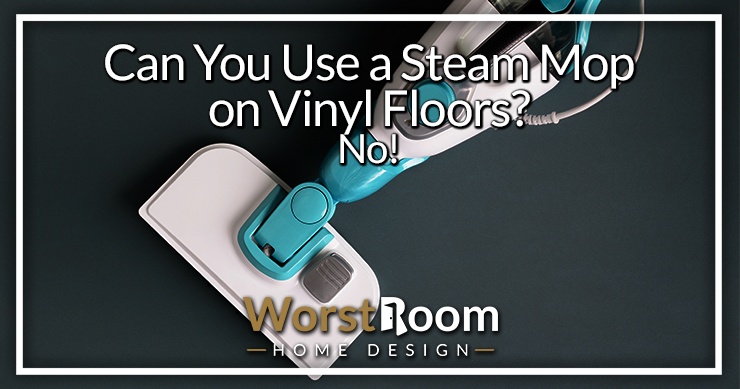
Did you move into a new home with vinyl flooring? The vinyl looks great, but it's an annoyance to clean. If you have vinyl flooring boards throughout the house, you'll find dirt between the floorboards, requiring excessive mopping and cleaning to keep it looking good. So, can you use a steam mop on vinyl floors?
Vinyl flooring is a popular choice for the kitchen, the lounge, the dining room, and outdoors on the porch. It's durable and long-lasting, and inexpensive. If you don't have the budget for tiles in your remodel, laying a new vinyl floor is a great way to save money.
Vinyl accumulates dirt quicker than most other flooring types; it acts like a magnet to grime and buildup. So, how do you keep it clean? Deep-cleaning flooring is a must for those spring cleaning sessions, especially when moving into a new home. Many homeowners decide to invest in a steam mop for those deep cleaning sessions or rent one from a hire company.
Can you use a steam mop on vinyl floors? No, you should not. They operate at such a high temperature that the heat will damage the sealant on the vinyl and cause delamination.
We put together this guide to help you understand steam mops and how they affect vinyl flooring. We'll also make suggestions on how to properly clean your floor, what products to use and which to avoid. Are you ready? Let's dive in!
What is a Steam Mop & How Does it Function?
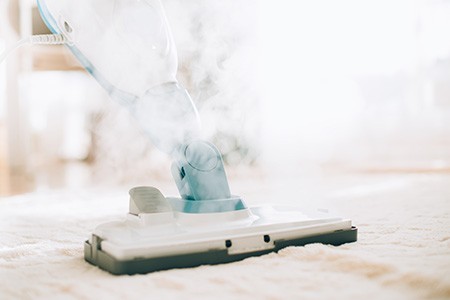
What is a steam mop, and why would you use it to clean your floors? This appliance offers you a fast and easy way to clean flooring. The steam mop works by heating water from its holding tanks, turning it into pressurized steam released through the mophead.
The steam exits the mophead at nearly 250 °F, blasting away stains and embedded dirt from the surface. The result is a clean, sanitized floor. The steam mop is ideal for cleaning old grubby tiles and outdoor areas that need a deep cleaning.
Can a Steam Mop Damage Vinyl Flooring?
Can you use a steam mop on vinyl flooring? The answer is a resounding no. A steam mop will damage the vinyl, releasing the bonding agent from the flooring and causing delamination of the layers. Vinyl or polyvinyl chloride (PVC) is a common household flooring material.
Manufacturers produce vinyl to create easy-to-clean, durable flooring that's affordable and easy to install. PVC plastic is easy to manipulate into various patterns and textures and patterns, making it a top choice for homeowners because it comes in many styles, colors, and finishes.
While it's a durable flooring material, the adhesives used in manufacturing can't stand up to the heat produced by a steam mop. It loosens, resulting in lifting and separation across the floor, ruining the vinyl material.
You may think that you could buy a steam mop with a temperature control but not only do these not exist, but you have to heat the water high enough to evaporate and form steam. These types of mops are designed to run at high temperatures, higher than your vinyl flooring can handle.
What Is the Best Mop to Use on Vinyl Flooring?
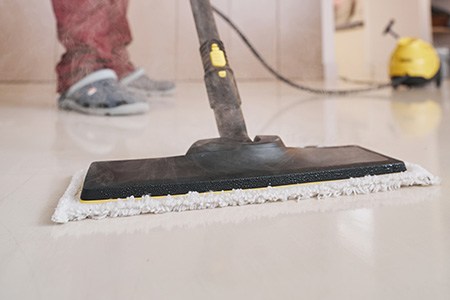
You can use any other mop on vinyl flooring, but not a steam mop. The best choice is a sponge mop or spray mop. Stay away from those old spaghetti mops, as they're difficult to work with and require hand-wringing which gets annoying.
If you have vinyl flooring in your home, don't let the floor get too wet. Pooling water on the surface might seep between the cracks in the boards, causing swelling and lifting of the panels. Microfiber, spin, and spray mops are the best choices for cleaning these floors.
Combine it with a good all-purpose cleaner like Fabuloso. Fabuloso is safe for vinyl wood or otherwise. Use a dilution ratio of 1/4-cup cleaner with a gallon of water. If you prefer, you can use Pine-Sol which is also safe for wood floors, vinyl floors, and any sealed surface.
Dip the mop in the water, wring it out and clean the floor. For areas with stubborn stains or grime, spray the undiluted floor cleaner on the spot and leave it to work for a few minutes before mopping it away. Just remember, no steam mop on vinyl floors, ever!
What Cleaning Products Should I Avoid Using on Vinyl Flooring?
Don't use harsh chemicals on your vinyl flooring. While it's fine to use products like Pine-Sol and Fabuloso, avoid using cleaners with ammonia or phosphorous. A pH-neutral cleaner is the best choice, and you should avoid using bleach on your floors. Also, it is never safe to mix Fabuloso and bleach.
Ammonia-based and phosphorus-based floor cleaning products and bleach can dull the floors, giving them a white sheen. Whatever you do, never combine bleach with ammonia cleaners.
It creates deadly chloramide gas that can burn your eyes and cause severe respiratory distress. A pH-neutral cleaning product won't have this harsh effect, and you get less streaking when the water dries.
Neutral cleaners also won't remove the protective layer on the vinyl flooring, whereas other, more aggressive products will strip it away, leaving it exposed to damage and looking lifeless.
How Do You Clean Vinyl Plank Flooring?
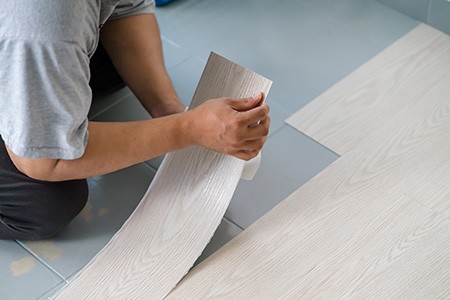
You need to take a multipronged approach to care for your vinyl flooring. Start your cleaning protocol using a brush or vacuum cleaner to clear away the surface dust and dirt on the surface. Use a soft-bristled brush for the task, and ensure you don't press too hard on the vacuum cleaner head.
After cleaning away the loose dirt, mix your floor cleaner with water and mop the floor. Using a concentration of more than ¼-cup of floor cleaner to a gallon of water. More isn't always better. Too strong a solution may result in a sticky floor. Worry about having a shiny vinyl floor after it's clean.
Natural Alternative Options for Cleaning Vinyl Floors
Floor cleaning products contain cleaning agents like o-Phenylphenol, p-Chloro-o-benzyl phenyl, and lactic acid. If you don't like using chemicals in your home, you can turn to natural alternatives.
Baking Soda
Baking soda is an effective cleaning agent for household use. If you have a big party and the floor is messy, mix a cup of baking soda into warm water and mop the floor. The baking soda lifts stains and absorbs odors, leaving your floors clean and your home smelling fresh.
When adding baking soda to the water, you'll notice a fizzing effect. Don't worry about it damaging your floors. This effervescence doesn't affect the flooring and won't cause lifting or delamination.
White Spirit Vinegar
Vinegar is also an effective natural cleaner. The vinegar strips away stains and dirt easily. Add a quarter cup of vinegar to a gallon of water. Never add vinegar to bleach, or you'll create deadly chlorine gas.
Never add bleach to other household cleaning products or hot water. All these agents will create chemical reactions resulting in harmful gases.
You can use it by itself or mix it with baking soda to create a supercharged multi-purpose cleaner for your floors. The vinegar smell might seem strong at first, but it dissipates quickly and absorbs bad odors from the air.
Cleaning Tips for Vinyl Flooring
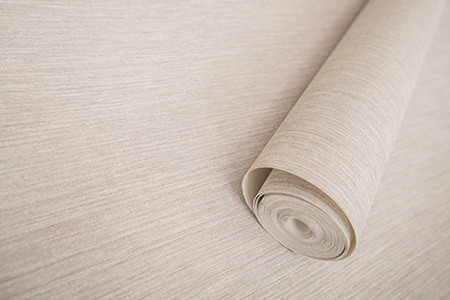
Here are a few extra tips for keeping your vinyl floors so clean you could eat off of them (but don't do that). They'll be as clean as if you could use a steam mop on vinyl floors.
If You Spill Something, Clean It Up Immediately
Vinyl flooring is a durable surface. However, if you have vinyl plank flooring, avoid letting water or liquids pool on the floor. The liquid can seep between the floorboards, swelling and lifting the boards.
There's also the potential for the liquid to get under the boards and cause mold and mildew growth. These fungi are dangerous pathogens. They release spores that cause allergic reactions, asthma, and respiratory issues.
Use a Soft Damp Cloth
Vinyl flooring is durable, but it's not indestructible. You can scratch it if you're using cleaning equipment with sharp edges. Don't use steel wool or scouring pads to clean tough stains off the floor. Add a squirt of concentrated floor cleaner to the affected area. Use a microfiber cloth and some elbow grease to wash it away. If this happens to you, here's how to fix vinyl floor scratches.
Vacuum or Sweep Regularly
Sweeping or vacuuming the floor daily is the best way to avoid the joints of your vinyl floor boards accumulating dirt. Use a soft-bristled brush and keep it clean.
Rub Out Scuffs
Don't stress if you see scuffs on your new vinyl floor. We have a few tricks to help you remove them. A pink pencil eraser is a great tool for removing stubborn scuffs from the floor. Rub lightly over the affected area, and you'll notice the scuff rub right off.
A tennis ball is great for removing tough scuffs from vinyl flooring. Use a circular rubbing motion on the scuff, and it lifts. When the other two methods don't work, give the stain a quick misting with WD-40 lubricating oil. The oil penetrates the stain, making it easy to rub it away.
Key Takeaways Regarding Steam Cleaning Vinyl Flooring
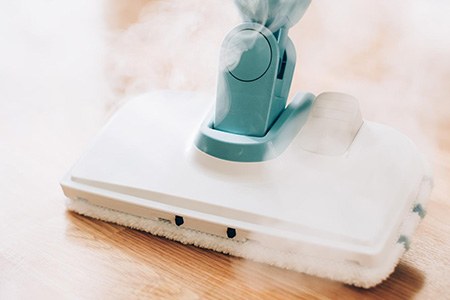
So can you use a steam mop on vinyl flooring? No. Let's break down the reasons below and what you can and should do instead.
- Never use a steam mop on your vinyl flooring. It can damage the adhesive layers. As a result, the flooring starts to lift, developing bubbles and cracks.
- Use a normal twist, sponge, or spin mop to clean the floors.
- Only use pH-neutral cleaning products and avoid bleach and ammonia or phosphorous-based cleaners.
- Don't let water pool on the floor, or it creeps between the boards, resulting in swelling and lifting.
- Try household items for cleaning your floors. Use vinegar and baking soda to remove tough stains and deodorize the floors.
- Sweep your floors often to reduce the buildup of grime in between the floorboards.
- Clean away tough stains and scuffs using a tennis ball or pink eraser.
- Using a lubricating oil like WD-40 helps to lift tough stains and scuffs from vinyl flooring as long as you clean the lubrication off afterwards.
That's the run down. Steam cleaning vinyl flooring is a no-go. There are much safer and better options for your flooring that will ultimately save you a ton of time and money from dealing with the damage a steam mop on vinyl floors would have created.
A Steam Mop on Vinyl Floors is a No-Go!
A standard sponge mop or push mop without the long tassels is the best way to keep a vinyl floor clean without also leaving you with streaks or excessive drying times. No matter what, for all the reasons listed above, do not use a steam mop on vinyl floors, period.




